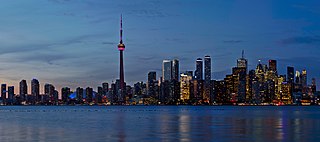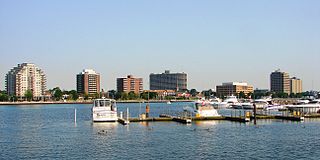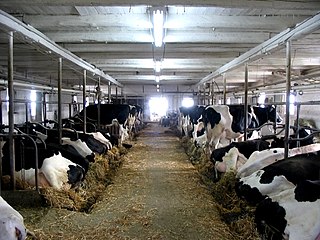Related Research Articles

The economy of Canada is a highly developed mixed economy, with the world's eighth-largest economy as of 2022, and a nominal GDP of approximately US$2.221 trillion. It is one of the world's largest trading nations, with a highly globalized economy. In 2021, Canadian trade in goods and services reached $2.016 trillion. Canada's exports totalled over $637 billion, while its imported goods were worth over $631 billion, of which approximately $391 billion originated from the United States. In 2018, Canada had a trade deficit in goods of $22 billion and a trade deficit in services of $25 billion. The Toronto Stock Exchange is the ninth-largest stock exchange in the world by market capitalization, listing over 1,500 companies with a combined market capitalization of over US$2 trillion.

Hamilton is a port city in the Canadian province of Ontario. Hamilton has a population of 569,353, and its census metropolitan area, which includes Burlington and Grimsby, has a population of 785,184. The city is approximately 45 kilometres (28 mi) southwest of Toronto in the Greater Toronto and Hamilton Area (GTHA).

Ontario is one of the thirteen provinces and territories of Canada. Located in Central Canada, it is Canada's most populous province, with 38.3 percent of the country's population, and is the second-largest province by total area. Ontario is Canada's fourth-largest jurisdiction in total area when the territories of the Northwest Territories and Nunavut are included. It is home to the nation's capital city, Ottawa, and the nation's most populous city, Toronto, which is Ontario's provincial capital.

Indigo Books & Music Inc., known as "Indigo" and stylized "!ndigo", is Canada's only major English-language bookstore chain. It is Canada's largest book, gift, and specialty toy retailer, operating stores in all ten provinces and one territory, and through a website offering a selection of books, toys, home décor, stationery, and gifts. Most Chapters and Indigo stores include a Starbucks café inside. As of 2022, Indigo has started selling music, and select audio equipment.

Canada has ten provinces and three territories that are sub-national administrative divisions under the jurisdiction of the Canadian Constitution. In the 1867 Canadian Confederation, three provinces of British North America—New Brunswick, Nova Scotia, and the Province of Canada —united to form a federation, becoming a fully independent country over the next century. Over its history, Canada's international borders have changed several times as it has added territories and provinces, making it the world's second-largest country by area.

Sarnia is a city in Lambton County, Ontario, Canada. It had a 2021 population of 72,047, and is the largest city on Lake Huron. Sarnia is located on the eastern bank of the junction between the Upper and Lower Great Lakes where Lake Huron flows into the St. Clair River in the Southwestern Ontario region, which forms the Canada–United States border, directly across from Port Huron, Michigan. The site's natural harbour first attracted the French explorer La Salle. He named the site "The Rapids" on 23 August 1679, when he had horses and men pull his 45-ton barque Le Griffon north against the nearly four-knot current of the St. Clair River.

Burlington is a city in the Regional Municipality of Halton at the west end of Lake Ontario in Ontario, Canada. Located approximately halfway between Toronto and Niagara Falls, it is part of the Greater Toronto Area and Hamilton metropolitan census area.

The Greater Toronto Area, commonly referred to as the GTA, includes the City of Toronto and the regional municipalities of Durham, Halton, Peel, and York. In total, the region contains 25 urban, suburban, and rural municipalities. The Greater Toronto Area begins in Burlington in Halton Region, and extends along Lake Ontario past downtown Toronto eastward to Clarington in Durham Region.

Whitchurch-Stouffville is a town in the Greater Toronto Area of Ontario, Canada, approximately 50 km (31 mi) north of downtown Toronto, and 55 km (34 mi) north-east of Toronto Pearson International Airport. It is 206.22 km2 (79.62 sq mi) in area, and located in the mid-eastern area of the Regional Municipality of York on the ecologically-sensitive Oak Ridges Moraine. Its motto since 1993 is "country close to the city".

Ontario came into being as a province of Canada in 1867 but historians use the term to cover its entire history. This article also covers the history of the territory Ontario now occupies.

Perth County is a county in the Canadian province of Ontario in Southwestern Ontario, 100 kilometres (62 mi) west of Toronto. Its population centres are Listowel, Mitchell and Milverton. The City of Stratford and the Town of St. Marys are within the Perth census division, but are separate from Perth County. The 2016 population of Perth County was 38,066.
Andrew Mitchell, is a Canadian politician. He served in the House of Commons of Canada from 1993 to 2006, representing Parry Sound—Muskoka as a member of the Liberal Party. He was a minister in the government of Jean Chrétien and a cabinet minister in the government of Paul Martin.

Floriculture is the study of the efficient production of the plants that produce showy, colorful flowers and foliage for human enjoyment and the human environment. It is a commercially successful branch of horticulture and agriculture found throughout the world. Efficient production practices have been developed over the years, for the hundreds of plant taxa used in the floral industry, increasing the overall knowledge of whole plant biology. Plant breeding and selection have produced tens of thousands of new genotypes for human use.
The Ontario tobacco belt is the tobacco-growing region located in Norfolk County and eastern Elgin County in Southwestern Ontario, Canada. The region is close to the north shore of Lake Erie, with a moderate climate and sandy, silt-loam soils that are well-suited to a wide variety of crops.

Canada is one of the largest agricultural producers and exporters in the world. As with other developed nations, the proportion of the population agriculture employed and agricultural GDP as a percentage of the national GDP fell dramatically over the 20th century, but it remains an important element of the Canadian economy. A wide range of agriculture is practised in Canada, from sprawling wheat fields of the prairies to summer produce of the Okanagan valley. In the federal government, overview of Canadian agriculture is the responsibility of the Department of Agriculture and Agri-Food.

This article is about the Economy of Hamilton, Ontario.

The economy of Ontario is diversified. Ontario is the largest economy in Canada, making up around 38% of Canadian GDP. Though manufacturing plays an important role in Ontario's economy responsible for 12.6% of Ontario's GDP, the service sector makes up the bulk, 77.9%, of the economy. Ontario's net debt-to-GDP ratio will rise to 40.7% in the year 2019–2020.

Christmas tree production in Canada totals from 3 to 6 million trees annually. Trees are produced in many of the provinces of Canada but the nation's leading producers are found in Quebec, Nova Scotia and Ontario, which account for 80 percent of Canadian tree production. Of the 900,000 trees produced annually in British Columbia, most are cut from native pine stands.

Canada's supply management, abbreviated SM, is a national agricultural policy framework used across the country, which controls the supply of dairy, poultry and eggs through production and import controls and pricing mechanisms. The supply management system was authorized by the 1972 Farm Products Agencies Act, which established the two national agencies that oversee the system. The Agriculture and Agri-Food Canada federal department is responsible for both the Canadian Dairy Commission and its analogue for eggs, chicken and turkey products, the Farm Products Council of Canada. Five national supply management organizations, the SM-5 Organizations — Egg Farmers of Canada (EFC), Turkey Farmers of Canada (TFC), Chicken Farmers of Canada (CFC), the Canadian Hatching Egg Producers (CHEP) and the Ottawa-based Canadian Dairy Commission (CDC), a Crown corporation — in collaboration with provincial and national governing agencies, organizations and committees, administer the supply management system.
Kentucky is an agricultural producer in the United States. Value of agricultural products was $5 billion in 2012, of which slightly less than half was crops. Crops grown in the state include corn, soybeans, hay, wheat and tobacco. Historically, hemp has been a cash crop in the state. Finished agricultural products produced in the state include Kentucky bourbon and Kentucky wine.
References
- ↑ Miller, M.M. (2001). "Floriculture industry overview: production, sales and marketing in North America". Acta Hort. (ISHS) 543:23-29
- ↑ Statistics Canada (2014). "Farm cash receipts 2013". Accessed November 22, 2014.
- ↑ Statistics Canada (2014). Census of Agriculture, farms classified by the North American industry classification. Accessed November 22, 2014.
- 1 2 3 Reid, N., & Carroll, M. (2005). "Using Cluster-Based Economic Development to Enhance the Economic Competitiveness of Northwest Ohio's Greenhouse Nursery Industry". In Papers and Proceedings of Applied Geography Conferences (Vol. 28, p. 309). [np]; 1998.
- ↑ Reid, N., Smith, B. W., Gatrell, J. D., & Carroll, M. C. (2009). "Importing Change: Canadian Competition and the US Floriculture Industry". The Industrial Geographer, 6(1), 3-19.